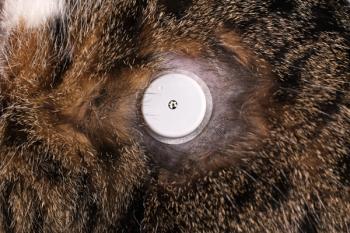
Consider ACTH stimulation test when you suspect canine hyperadrenocorticism
Increased ACTH secretion from the pituitary gland is the most commonly recognized cause of canine hyperadrenocorticism (HAC).
Increased ACTH secretion from the pituitary gland is the most commonly recognized cause of canine hyperadrenocorticism (HAC). Functional adrenocortical adenomas or carcinomas that auto- nomously secrete cortisol comprise the remaining natural occurrence of HAC in our classical understanding of this endocrinopathy.
Figure 1: Abbreviated steroid production pathway - adapted from (2) Ristic - shows those steroid hormones evaluated by the adrenal panel profile. Note: Trilostane inhibits those pathways involving 3B hydroxysteroid dehydrogenase.
Terms often are used interchangeably, but it is important to distinguish the difference between the definition of HAC and Cushing's syndrome. HAC is defined as an overproduction of steroid hormones from the adrenal cortex. Cushing's syndrome refers to HAC with excess production of cortisol. Finally, atypical Cushing's disease refers to HAC caused by increased levels of intermediate adrenal steroids (aka sex steroids.)
Jack Oliver, DVM, PhD,, reviews this syndrome in the ACVIM Forum Proceedings 2007 471-473. "Steroid Profiles in the Diagnosis of Canine Adrenal Disorders."
Signs associated with HAC range from subtle to profound, and may be seen in both traditional and atypical disease. Excessive panting sometimes is the only client concern (Table 1). Other disease processes can cause clinical signs associated with HAC, so it is important to rule out different inflammatory, metabolic and neoplastic processes before initiating therapy. Baseline CBC, biochemical profile, urine analysis/culture, thyroid hormone profile and radiographs/ultra- sonographic imaging are recommended in these cases.
Various tests are advocated as screening and differentiating tools to identify those patients with HAC characterized by increased cortisol secretion.
Table 1
Despite clinical impressions and supportive laboratory data, some dogs with HAC fail to be diagnosed with these tests. It is now clear that steroids other than cortisol influence the hypo- thalamic-pituitary axis and cause clinical signs.
Researchers have investigated measurement of serum 17-hydroxyprogesterone concentration alone after ACTH administration as an additional tool to identify those dogs. Ristic J.M.E, et al. (OR Ramsey, I.K., Heath, F.M., Evans, H.J., Herrtage. M.E.) The Use of 17-Hydroxyprogesterone in the Diagnosis of Canine Hyperadrenocorticism. J Am Vet Med Assoc. 2002; 16: 433-439. Mixed results indicate that quantification of additional intermediate steroids is warranted. The Clinical Endocrinology Service at the University of Tennessee performs adrenal function testing. Those dogs with certain abnormal steroid profiles/ adrenal sex hormone excess have been characterized as atypical Cushing's cases. Atypical cushingoid dogs may have pituitary or adrenal-dependent HAC.
Currently, steroids measured in the adrenal panel are cortisol, androstendione, estradiol, progesterone, 17-OH progesterone and aldosterone. An abbreviated production pathway is shown in Figure 1.
One hypothesis explaining abnormal elevations of these steroids in dogs with primary adrenal tumors is an increased and continuous stimulatory effect of luteinizing hormone causing adrenocortical tumor development. Oliver notes human studies show that some hyperplastic or neoplastic adrenal tissue may be under control of various ectopic or aberrant hormone receptors.
The adrenal panel is performed using the ACTH stimulation test protocols using either ACTH Gel or Cortrosyn®. Cortisol and five other steroid values are reported for each sample. For more detailed information go to (
Treatment options include the familiar Lysodren®, ketoconazole and, more recently, trilostane.
In some cases, especially if alopecia is present, melatonin supplementation may be instituted. Clinical results may not be appreciated for two to three months. Though melatonin is inexpensive, response to treatment is sometimes equivocal.
The addition of flaxseed oil with ligands may aide in efficacy.
Treatment response is monitored by client communications, physical exams and follow-up stimulation tests with comparison of the adrenal panels.
Follow-up frequency varies with individual patient response to therapy. Recheck stimulation tests are indicated if there is change in the clinical picture.
Treatment modalities will variably influence the specific steroid profiles. Recommendations for treatment options are included with the panel results for the University of Tennessee Veterinary Endocrinology Laboratory.
by Ronald Lyman, DVM, Dipl. ACVIM
Dr. Lyman is a graduate of The Ohio State University College of Veterinary Medicine. He completed a formal internship at the Animal Medical Center in New York City. He is a co-author of chapters in the 2000 editions of Kirk's Current Veterinary Therapy XIII and Quick Reference to Veterinary Medicine.
by Angela Murphy, DVM
Angela Murphy is a graduate of the Virginia-Maryland Regional College of Veterinary Medicine. She currently works at the Animal Emergency and Referral Center in Fort Pierce, Fla., where she is an internal medicine resident of the ACVIM.
Newsletter
From exam room tips to practice management insights, get trusted veterinary news delivered straight to your inbox—subscribe to dvm360.




